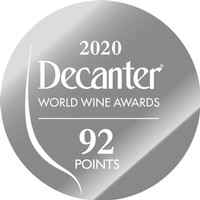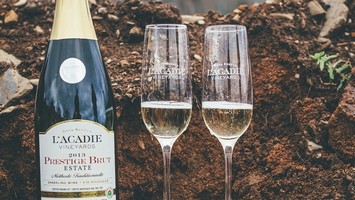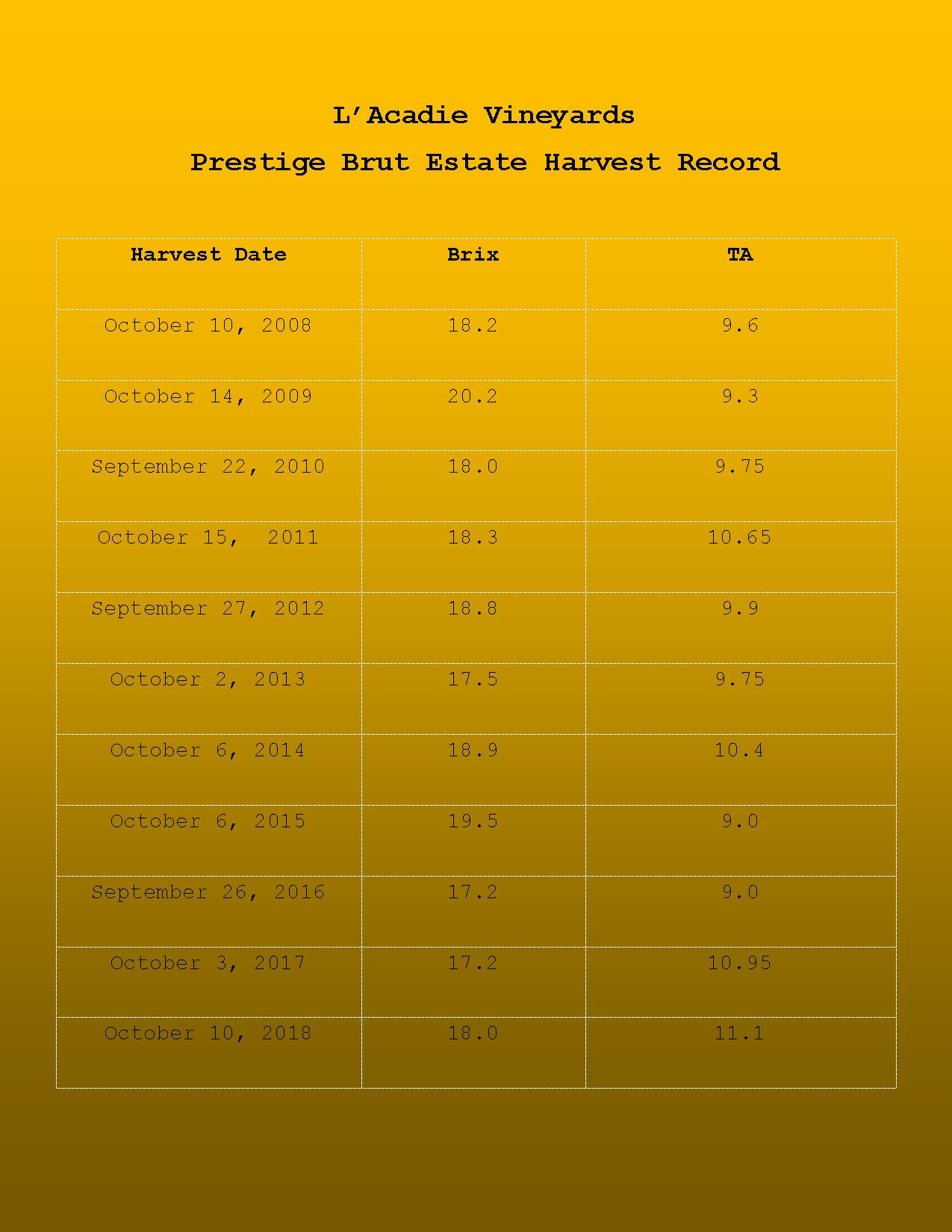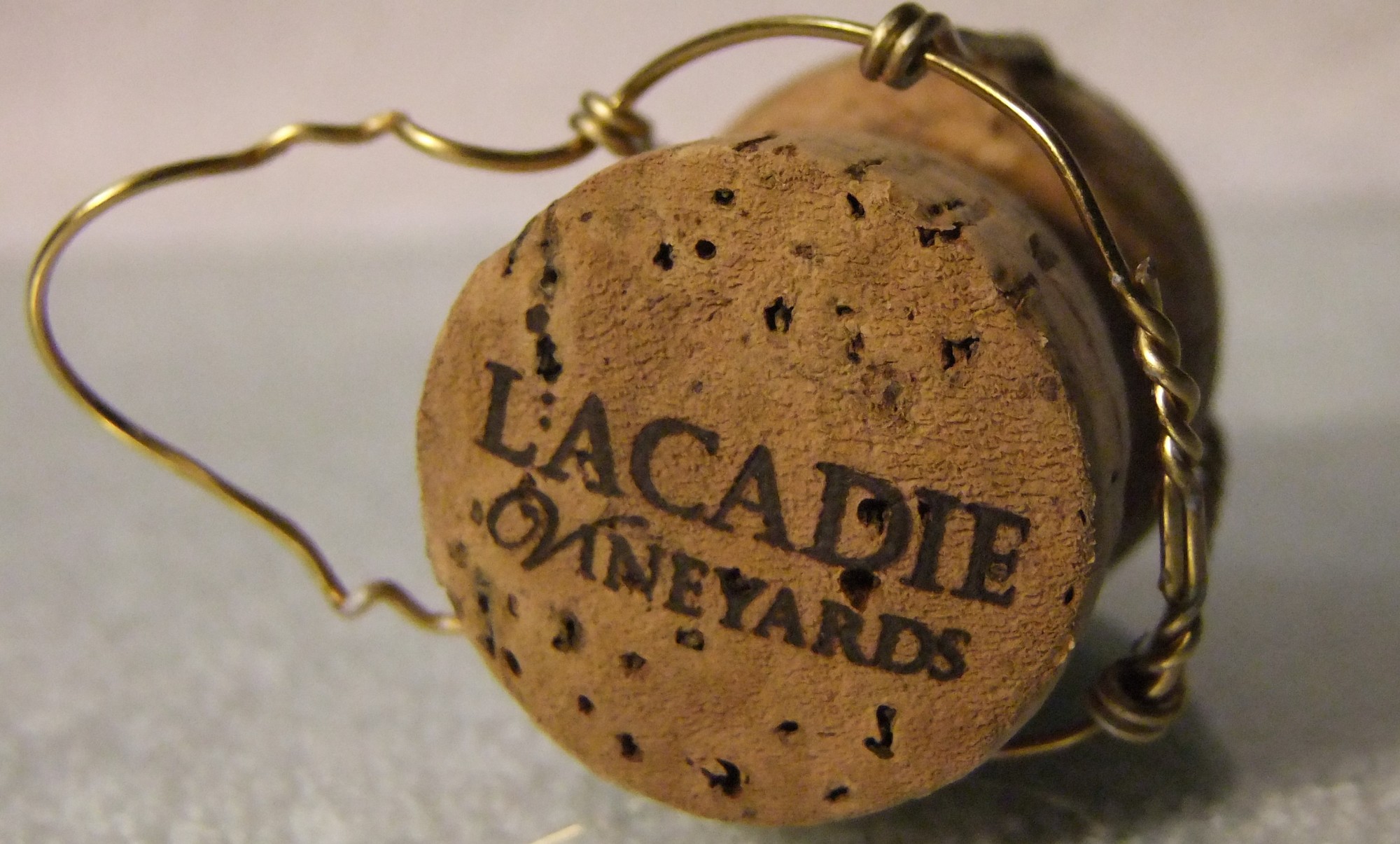L'Acadie Vineyards Blog
Welcome to the L'Acadie Vineyards blog and winery news
Tim Pawsey aka Hired Belly, Vancouver - L’Acadie Vineyards: Nova Scotia’s Sparkling Stalwart
L’Acadie Vineyards: Nova Scotia’s Sparkling Stalwart
I’m intrigued (and inspired) by winemakers who really do ‘push the envelope.’ And Bruce Ewert is one of those winemakers. Ever since Ewert left BC for Nova Scotia to make wine in Nova Scotia’s Annapolis Valley I’ve been following his progress—and, in particular, L’Acadie Vineyards’ success in sparkling wine.
Born in Prince George, and a graduate of UBC, Ewert cut his viticultural teeth working across the country in various winemaking capacities for Andrés Wines. He started out in Port Moody, BC, before heading to Winona, Ontario and Truro, Nova Scotia. Along the way he worked vintages in Australia and California and returned to BC in 1995.
In those early days Ewert consulted to Sumac Ridge and Hawthorne Mountain (now SYL Ranch) and went on to explore sparkling wine at Summerhill. His wife, Pauline Scott, hails from Nova Scotia. Hence, he says, when it came to looking for affordable land on which to launch L’Acadie Vineyards (in 2004), then still emerging Annapolis Valley was an obvious choice.
Ewert was determined to follow the mantra “the right grape for the right site.” In this case he felt strongly that the right grape was l’Acadie Blanc. It’s a Canadian, cold-hardy hybrid of Seibel and Villard which is now widely planted in Nova Scotia. And he knew that the ancient seabed of the Gaspereau Valley—defined by schist and sandstone—was the perfect site.
Bruce Ewert
The winemaker was also drawn to L’Acadie Blanc’s higher acid, less fruit-driven profile. Noting at the time that nobody in Nova Scotia was making bubble he was convinced it would make “a wonderful sparkling wine.” Moreover, when it came to sparkling, Bruce was definitely bullish on Annapolis Valley rather than the Okanagan. There he reckoned (even over a decade ago) that consistently higher sugars were proving too challenging for sparkling.
As it turned out, he was likely witnessing the early signs of what we have now come to understand more urgently as climate change. On an already brief cycle of the vine, no one is immune to its impact, he notes. “Bud break now sometimes comes later than usual, and first frost possibly earlier. And even though winters may be getting milder, it’s not a certainty.”
Overall, though, his observation that Nova Scotia has considerably less heat units more than paid off in terms of consistently seeing more moderate sugar levels and good acid retention. And the L’Acadie grape has adapted, he says, “amazingly well, shortened its cycle through flowering and veraison, and still ripens for sparkling.”
In conclusion, it’s truly rewarding to see L’Acadie Vineyards making a name for itself—especially building the reputation of Canadian Traditional Method sparkling. It’s surely one of our most under-appreciated styles with plenty of potential—and sites not yet explored.
L’Acadie Vintage Cuvée 2017 (Annapolis Valley)
[L'Acadie Vineyards Vintage Cuvée 2017]
This blend of 92% estate-grown L’Acadie Blanc with 8% Annapolis Valley Seyval Blanc is certified organic and aged on the lees for before its first disgorging in June 2019. Here the L’Acadie and its suitability to sparkling truly shines through. Forward citrus, apple and toasty notes with anise hints, a stream of fine bubbles with persistent mousse, quite creamy and citrus on the palate with mineral undertones, excellent structure and zesty notes to close. Excellent now but also should evolve nicely in the bottle. 92 pts. $30.26 (winery). Also at some BC private stores.
L’Acadie Vintage Cuvée Rosé 2017 (Annapolis Valley & Cape Breton)
[L'Acadie Vineyards Vintage Cuvée Rosé 2017]
A blend of L’Acadie Blanc (36%) and Marechal Foch (55%), with 7% Leon Millot and 1% Luci Kuhlman from Cape Breton, plus 1% Seyval. Pale to medium salmon coloured with inviting, vibrant red berries and some sage and earthy hints. Fine bubbles and a gentle mousse lead to a crisp palate wrapped in appealing acidity, with rhubarb, strawberry and cherry notes, with some minerality in the background and that lively acidity—which just keeps on going, makes it very food flexible. Certified organic. 90 pts. $30.26 (winery). Also at some BC private stores.
Prestige Brut Estate 2014 (Annapolis Valley)
[L'Acadie Vineyards Prestige Brut Rosé 2014]
Made entirely with estate fruit from the initial 2005 plantings on schist, sandstone and sand, the soils really come through on this very Champagne-like sparkling wine, which lures with definite brioche, almond and toasty notes before a textured, mouth-filling palate of stonefruit and apple, above mineral undertones. Almost six years on lees delivers impressive but elegant heft and full-bodied character through a lengthy end. Certified organic. 91 pts. $43.30 (winery) BCLS (2013) $55.99.
[The Ewert family]
The Ewert Family
Full article click here
92 points and Silver for 2014 Prestige Brut Estate at Decanter World Wine Awards

2020 Decanter World Wine Awards in London, England awarded new release 2014 Prestige Brut Estate silver AND 92 points!! By our count, it is the highest scoring sparkling wine across Canada (tied with Fitzpatrick Winery in British Columbia) And succeeds the sold out 2013 Prestige Brut Estate that also earned silver and 92 points at the 2018 competition.
Terroir and Organics

The grapevines that grow at L’Acadie Vineyards would tell you that they’ve had to work hard to get where they are today and that they are extremely proud of the flavours that they extract from the warm, dry, rocky, sometimes inhospitable conditions that they grew up in. Now in their 15th year their roots reach over a metre deep and the deeper they go the more minerals, flavours and water they can access that give our Estate wines their unique character. Helping them along the way is a complex ecosystem of fungi, worms and bacteria that our organic practices have been carefully managing and nurturing. It is this link between terroir and organics that the best wines of the world are based on.
We chose our site for the rocks back in 2004. I had been making traditional method sparkling in Okanagan for years, and before that in Ontario, California and Australia, and we were looking for a site to produce the first sparkling wine for Nova Scotia. And we wanted to do it organically after my head was turned, and my path changed, at Summerhill Pyramid winery in Kelowna, an organic winery. As head winemaker, I saw better flavours from grapes farmed organically, after many years working with conventional grapes. Our Nova Scotia vineyard search started in the 90’s on working vacations returning to Pauline’s home province of nine generations. The Annapolis Valley was the focus with it’s climate moderated by the Bay of Fundy, and the Gaspereau Valley sub-appellation was intriguing for both it’s proximity to the bay, and shelter with the Wolfville ridge. The mantra at the time was “south slope, south slope…” but we found a ribbon of ancient seabed with good drainage along the base of the south mountain, facing north-west, that was calling to us. The south-facing other side of the valley had clay loam, typical for Nova Scotia, but I thought a better soil for sparkling was rocky and well drained, making it warmer in the spring and mineral rich from the fractured schist and sandstone deposits - all sedimentary rocks in their origins. Another plus was that the property had been fallow for decades, used for grazing horses, and we could skip the usual three year transition to be organic.
Plants weren’t always on land. Their origins are in the sea being bathed in nutrients constantly, a nice gig. When they made their hardy evolutionary step to land they had to form an alliance with soil organisms to survive, a symbiosis, and in exchange for a small amount of nutritious sap, the organisms living around their roots help them breakdown and make all sorts of nutrients and minerals available to the vines. Root zone influence increases to 2-10 times with this network of mycorrhizal fungi, accessing more nutrients and more flavours. But these microbes are delicate and the rise of pesticide-focused agriculture in the 1950’s reduced their populations significantly. The result is dead soil where the plants have to be fed non-organic usually petroleum-based fertilizers directly… an old adage in organic farming, “with organics you feed the soil, in conventional farming you feed the plant” But with this conventional approach the vines are also less able to extract flavour from the soil, resulting in wines with less terroir flavours, less sense of place, less soul.

We have farmed our site organically from inception, largely to promote a living soil for better terroir flavours. We planted with cuttings propagated in an organic mixture of peat moss, alfalfa and lime, and to decrease weed competition, used a dead mulch of wood shavings and later a living mulch of clover under the vines. Composts teas are brewed in our 300 litre brew tank with composted pomace from the winery, managed with aeration to encourage a fungal-dominant compost. An organic inspector once told me that they were convinced that compost tea and kelp foliars are all a plant needs to thrive in a living soil, by both stimulating growth and encouraging a healthy soil. Foliar teas also help disease control by crowding out opportunistic disease organisms on the leaves and clusters with beneficial organisms. Our recent participation in a three year provincial Terroir Study helped us understand more about our soil- prompting us to renew our cover crop by cultivating and seeding clover. Benefits are aeration and nutrient release and we are further investigating new cover crops to match our terroir. Studies with several universities are qualifying the types of organisms present in our soil, on our leaves and clusters, and in our wild ferments.
There are transitions to organics happening around the wine world, recently from British Columbia’s gigantic Mission Hill and their growing list of winery holdings, and large French wineries such as Roederer. A quote from their winemaker about the iconic, and expensive, champagne Cristal, ” At that price, I just don’t feel comfortable not being organic.” Spanish wine region Penedes has the most ambitious goal - all vineyards within the region will have to be organic by 2025, reflecting a strong commitment to organic viticulture.
The organic practices at L’Acadie Vineyards encourage the terroir signature of our estate – minerality and slight saline flavours from schist and sandstone, and I am confident that future generations of our family will be producing estate wines such as Prestige Brut Estate and Estate L'Acadie with those flavours for years to come.
Cooler Climate Nova Scotia
Making sparkling wines on the fringe of possibility has its rewards and risks. On the positive side of the equation is world class sparkling wine with ripe grapes at enviable acid levels and moderate sugars. We are right on the cusp of not being able to do what we do, but grapes seem to react to the stresses and reward us with our signature cool climate flavours. It’s been 15 years since planting our estate vineyard with L’Acadie blanc and we have seen remarkable adaptation and resilience to the rigours of a cool climate. And those risks are many – winter damage if temperatures dip below-20C , frosts on either end of the growing season and attaining enough heat units to ripen in our short growing season.
But is our region being affected by global warming? Is it getting easier? That’s a question posed to me recently by a wine writer. My answer: A guarded yes. Yes, when you look at how our climate has warmed over the last 50 years when research scientists at Agriculture Canada in Kentville determined it was too cold in Nova Scotia to support a wine industry. And yes, to the possibilities of vinifera growing here. But our region’s cooler personality can still rear it’s ugly head, like the 2018 spring frost, or described by many as a spring freeze. Temperatures dropped to -2.8C at our estate on June 4 and damaged 80% of our young primary shoots. This was a first for the region’s relatively young grape industry and affected some crops levels severely. We had a second bud burst in late June and those secondary shoots made up for lost time and showed remarkable growth, racing to achieve flowering and verasion at the historical benchmarks and ripening grapes for sparkling wine. An amazing adaptation to a 120 day season compared to our normal 180 frost free days. Crop levels were low, which was beneficial for future growth considering the stresses that the vines endured. We had to adjust distribution for our small production of 2018 still wines and NSLC was accommodating to allow us to restrict their shelf space for a year, so that we could sell direct.
So should we expect more fluctuations in weather, more extreme events? Is that the compromise to the benefits of a warming trend? A look at historical harvest information for sparkling – dates, sugars, acids, is an interesting exercise to see the effects. Champagne has heaps of data for this type of analysis and they have shown that harvest dates have been getting earlier to achieve optimal balance of moderate sugars and enough acidity in their warming climate. I experienced this when I was making sparkling in BC’s Okanagan Valley where the sugar accumulation outpaced ripening in +35C heat and I had to pick before sugars were too high and acid dropped out. But unripe grapes are not ideal for quality sparkling wine and just picking earlier in not always the answer. We’ve had enviable ripeness at our estate for 10 years, including last year. The seeds are lignified, brown, and there are ripe flavours. And harvest dates don’t seem to be trending earlier significantly, as shown in the 10-year harvest record below. And not major fluctuations either. It’s a small sample set compared to Champagne’s 100+ years of data, but significant for our emerging region. Hopefully these enviable quality indicators will continue for many future vintages, in our “cooler climate”.

Traceability and Organic Wine
Do you know where the wine in your glass was grown? A winery can choose to use an appellation designation to give you validated information, and of course there is the required country of origin on the label, or wineries can simply share unverified vineyard sources on back labels. Much like appellation systems control a region’s wines, the Canadian Organic Standard controls organic wines and can be trusted to ensure the organic grape content in the bottle through rigorous inspections.
The Canada Organic symbol on a bottle of organic wine is controlled by the Canadian Food Inspection Agency and is the only validation to consumers of organic grapes, organic wine production and no GMO products – all inspected by a certifying body. The traceability audit is one of the many facets of an organic winery’s operations that are scrutinized on an annual basis. Record keeping has to be exemplary for the inspector to trace wines back to specific parcels of vineyards, and to ensure proper chain of custody and non-contamination. And each grower that supplies grapes must be organic themselves, providing a vital record for the wine audit. This traceability is one of the major foundations behind the organic symbol on the bottle.
Scrutiny in food production has steadily increased for food safety, sustainable efforts and consumer demand. The pandemic has intensified that consumer demand, with authenticity and local origin catapulting to the main stage. Traceability is becoming more important to wine drinkers to ensure authenticity and avoid counterfeit wines, a problem associated with high end prestige wines that is now creeping into lower price points. Solutions such as Blockchain, a transparent and secure record system that is most famous for Bitcoin transactions, are starting to be applied to build trust between wineries and consumers. Is the future QR codes on bottles that trace the wine right to the grape source? Perhaps, but right now consumers can trust a symbol that is transparent, validated and authentic and that is the Canada Organic symbol.
Reading our Labels
Wine writers have complimented us that our labels have an "abundance of information" and we couldn't agree more. Our goal is to enlighten buyers so they can make an informed decision in a marketplace crowded with marketing names and slogans. Here are five information nuggets that you'll find on our labels:
The most important information on our label is the Canada Organic symbol and certifying inspector, Pro-Cert. There is hard work, passion and risk-taking to make a organic wine and the status tells buyers that only natural inputs were used to grow and make the wine. You can't put organic on the label or website next to a wine unless it is certified with thorough inspections that include a traceability audit to ensure only organic grapes went into the bottle.
We declare the grape varieties that go into our blends on the back label. If you want to declare a varietal on the front label, current wine standards in Nova Scotia require at least 85% of the declared variety. An example is Estate L'Acadie, which is 100% L'Acadie blanc from our estate vineyard next to the winery.
We declare the geographic area where our grapes are sourced. We have several certified organic growers that we buy grapes from, and their certificates become part of our traceability. I'm a winemaker from British Columbia, a wine region that is built on a quality standard called Vintners Quality Alliance, VQA. In the early days, the VQA bottle mark contributed greatly to consumer confidence of 100% BC grapes. Now there is further refinement with smaller geographic areas such as Okanagan Valley, Similkameen Valley, Vancouver Island and more and more areas as they define their unique terroir. We follow the same format of declaring either Annapolis Valley, Gaspereau Valley or sometimes the larger geographic area, Nova Scotia, when the two areas (and a small new grower in Cape Breton) are blended.
We add dosage, called expedition liquour in France, to our traditional method sparkling wines when we disgorge. The goal is to balance acidity and quality enhancement -think of dosage as a thread that weaves all the components of sparkling wine together. We declare it on the back label in grams per litre (g/l) and it gives the buyer an indication of sweetness. For example Brut is a designation for sparklings that are between 0-15 g/l dosage, which most of our wines fall under. Remember that if the base wine had elevated acidity, which is not uncommon in our cool climate, the corresponding dosage might be high as well, but the taste might not be perceived as sweet.
We recently added a statement on our back label, "Suitable for vegan diets", after many of our fans asked for it. This means that we do not use any animal products in our wine - a practice that we have been following for many years.
These five pieces of information that we include on our labels are not required but we choose to include them to inform the buyer. I hope you find this useful next time you pick up a bottle of our organic wine.
Recently Disgorged
Recently disgorged, RD, is a term coined by Madame Bollinger in Champagne in the 1960’s and is very popular in Europe where larger Champagne houses are not as capable as smaller grower wineries. L'Acadie Vineyards also offers recently disgorged sparkling wines, usually a month or a couple of weeks on the cork- fresh, fruity and lively. Buying direct from the winery is your best access.
Disgorging or degourgement is the act of removing the yeast from the bottle, adding a dosage of wine and sugar to balance natural acidity and corking the bottle. Like smaller grower Champagne wineries we are able to disgorge in small batches and have a small radius of distribution, compared to larger companies that have equipment to process large numbers of bottles and then ship to all points of the globe, on the cork for sometimes many years.
Bubbly ages like a white wine after the yeast is removed, fresh, fruity, vital style in the first several months, and rich and biscuit after one or more years. Look at the cork next time you open it – if it maintains that mushroom shape, it’s been in the bottle over a year, and if not, it is recently disgorged.
Lightening before the Thunder
Nova Scotia sparkling wine. If you haven't heard of it by now, you'll soon have your head turned as this specialized wine style catapults and rejuvenates Nova Scotia tourism. Yes, the word is out and wine enthusiasts from across Canada and beyond are poised to visit our wine region. They know that our superior cool climate can produce world class, awarded traditional method sparkling wine that rivals Champagne and that we have many producers carefully fermenting in their bottles and aging them on their sides as they wait for the right moment to pop the cork. Yes, you could say there is a "thunder" of cork popping, but did you know about the "lightening before the thunder"?
L'Acadie Vineyards is the birthplace of Nova Scotia sparkling wine, releasing the region's first traditional method sparklings in 2008. Many factors and years combined for this genesis - experienced British Columbia sparkling winemaker, ninth-generation Nova Scotia partner and discovering an arcadia of schist and ancient seabed. Read more. And international awards have validated the risks taken. Prestige Brut received a Gold and was Top Scoring Sparkling at the leading 2010 Canadian Wine Awards. Only three sparkling wines had ever achieved gold in the history of the competition. At the prestigious Effervescents du Monde competition in France, 2007 and 2010 Prestige Brut were awarded silver medals. Current release 2013 Prestige Brut, buy now, received 92 points at Decanter World Wine Awards in London, England. These international, national and regional awards and recognition have been significant in not only the success of L'Acadie Vineyards but also the enviable image, and thunder, that Nova Scotia enjoys today.
"Bruce Ewert released Nova Scotia’s first Champagne-method sparkling wine back in 2008. The local industry owes much to his foresight” -Beppi Crosariol, Globe and Mail
This 2020 season we are offering tastings by appointment, book now, to give a more intimate and safe experience. Consider booking a sparkling tasting on the crush pad outside and taste and learn why our Nova Scotia sparkling is so popular.

